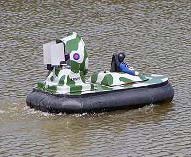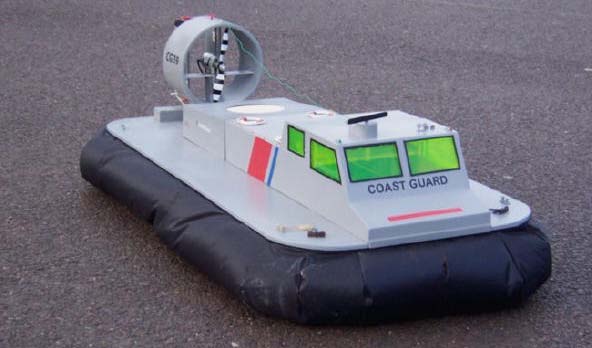
|
|
|
|
Model Hovercraft(Reprint of an article from the March 2008, Spring SRCMBC Newsletter)Several people down at the pond have taken an interest in my hovercraft so I thought I would write an article on them. I started building model hovercraft as I was looking for something different and out of the ordinary. As I live in Salisbury I needed something I could also operate away from the pond. This type of craft certainly appeared to fit the bill. 
Basically there are two types of real hovercraft, so models follow the same pattern. First there is the type, which has one single motor, which drives a large propeller in a single duct at the rear of the craft. Some of the airflow is then diverted through a splitter plate in the bottom of the duct. About a third of the air goes down into the skirt and exits under the craft where the air cushion is formed. The rest of the air is used to propel the craft forward. With this type it is not possible to fully hover when static as there will always be air-pushing foreword. This type of craft is like the one in picture left. It is the type of model I have taken to Calshot RNLI day and to Setley pond. Flying this sort of craft is fairly difficult as you have less control. You have to go to two-thirds power just to inflate the skirt and form the air cushion. The craft then starts to move and can then go on full power. When stopping, the tendency is to shut everything down and she just grinds to a halt and sits on the water. Turning is easy as it can turn more or less in it's own length. It does however have a tendency to want to flip over, especially in rough conditions. As it has a large 9-inch propeller things can also get hot. The motor in mine has been recorded pulling over 30 Amps. Recently on my new Aero Racer I had smoke coming out of it when a connector melted. 
The other type of hovercraft is like the passenger ones we see locally. They have a separate lift system to the main propulsion unit. The model can do anything a real one can do. The model construction is also the same with separate air ducts for lift and propulsion. When the skirt is removed the frame is the same as on the old SRN6 hovercraft. I know this as I got under one and had a look For a model hovercraft this is the best sort to build. However it is much more difficult to construct and needs practice to operate. Flying this type of model can be more fun as you have a lot more control. You can do anything the real one does with practice. It can be hovered whilst the craft is stationary. You can pull away gently increasing speed as you go. When stopping you can slow it on the main motor and in emergency reduce the pressure in the skirt so as to act as an additional brake.Turning is also easier. As you become more experienced you soon learn to master using the skirt pressure in combination to the rudders and main propulsion unit to control the craft. It may sound complicated but it is not. I would think that anyone who operates a model sailing craft would need a lot more skill than I would with the hovercraft. Model hovercraft are also easier to operate on water than on land. This is because the air under the craft takes a different form. On water the air forms a shape of an upturned saucer with most of the air being distributed around the inner edge of the skirt under the plenum and the water being pushed to the centre. On land the air is simply directed straight down. Believe me there is a noticeable difference. Both of the pictured craft have been disposed of. The camouflaged one was written off due to a design fault, which caused it to break its back at a certain weak point. The designer has modified the kit and supplied me with a new craft. The larger one was used at the school where I work and was used during lessons. It's great beingi paid to do you hobby. It was never put on water and only operated on the tennisi courts. It ended up needing the skirt replacing due to misuse. As I had made several mistakes in the construction I decided it was more economical to give it away ratheri than do repairs. I stripped it of all electronics and gave it to the school. They got iti going as a project and it is still operational to this day but seldom used owing toi insurance problems. While on the subject of insurance you are covered by the Club's insurance, however, as I am a member of the Model Hovercraft Association I also have extra cover. I am now in the process of building a new hovercraft. This one will be 42 inches long and 18 inches wide. Propulsion will be by a 9-volt brush less motor driving a 7-inch propeller with forward and reverse thrust. A brushed 600 motor driving a 6-inchpropeller will provide lift. Like the experimental one I operate it will be giro stabilised so as to keep the craft in a straight line. This takes a lot of the workload off of the operator when flying. With the giro disengaged you are constantly trying to correct the movement left and right and in doing so tend to keep over correcting the rudder. This in turn causes it to zig zag uncontrollably. The new craft will be constructed using 0.04 and 0.08mm plywood and 6mm balsa strip. The skirt will be made form Rip Stop Nylon. Hopefully I can keep the weight down to around 8 lbs gross. Having said that I do know of a person who is operating a similar size craft weighing 12 lbs. If anyone would like more information regarding model hovercraft please feel free to contact me. My telephone number is 01722 333369. Pete Bryant |
